Introduction
Throughout American history, few scandals have captured the public imagination quite like the affairs of its presidents. One of the most infamous cases is that of Bill Clinton and Monica Lewinsky, which rocked the late 1990s. This affair not only brought forth questions about the moral compass of leaders but also reflected the shifting societal norms of the time. At the heart of it, we find themes of power, passion, and ultimate deceit, mirroring today’s discussions about accountability, gender dynamics, and the role of media in political life.
The Scandal
The details of Bill Clinton’s affair with Monica Lewinsky are well-known yet still shocking years later. Their relationship began in 1995 when Lewinsky was a 22-year-old intern at the White House, and Clinton was a sitting president in his mid-40s. The scandal erupted publicly in January 1998, when reports surfaced that Clinton had engaged in inappropriate behavior with Lewinsky, leading to the grand jury testimony which revealed the infamous phrase, “I did not have sexual relations with that woman.”
The situation escalated when news broke of a blue dress— evidence that contained Clinton’s DNA—providing tangible proof of their tryst. The public’s reaction was swift and divided. Some vehemently condemned Clinton for his actions, viewing him as a moral failing for the leader of the free world. Others aligned with him, viewing the scandal as an attempt by political rivals to undermine his presidency.
Key players in the unfolding drama included Linda Tripp, a former colleague of Lewinsky’s, who recorded their conversations and turned them over to investigators, and Kenneth Starr, the independent counsel whose probing led to Clinton’s impeachment in December 1998.
Moral and Cultural Analysis
The societal reaction to Clinton’s affair was intense. The late ’90s were marked by a cultural shift where the intersection of media and politics was still relatively new. While the public was fascinated, opinions split along partisan lines. Some saw the scandal as a violation of trust; others dismissed it as a personal matter, viewing the political and personal spheres as distinctly separate.
Consequences for Clinton were severe yet complex: he was impeached by the House of Representatives but acquitted by the Senate. His presidency ended with strong approval ratings, showcasing a disconnect between public opinion and the conventional wisdom of judgment based on moral conduct.
Today, the scandal would be viewed through a different lens, especially in the context of the #MeToo movement and ongoing discussions about power dynamics in relationships. The narrative would likely shift toward the imbalance of power between an older, established political figure and a young intern, highlighting issues of consent and exploitation in a way that was less prevalent in discussions during the 90s.
Comparing Past and Present
- Public Scrutiny: The advent of social media would amplify reactions today, with public opinion forming in real-time.
- Gender Dynamics: Today’s discourse acknowledges the potential exploitation inherent in relationships where power differentials exist.
- Political Consequences: Modern politicians are held to different standards, with some facing immediate consequences for personal misconduct, reflecting societal shifts towards accountability.
In examining the Clinton-Lewinsky scandal and its implications, we see the evolution of societal values and how they resonate in contemporary culture, prompting a reevaluation of past events through a modern lens. The legacy of such scandals continues to shape conversations around ethics, integrity, and the power struggles that linger within political corridors.

